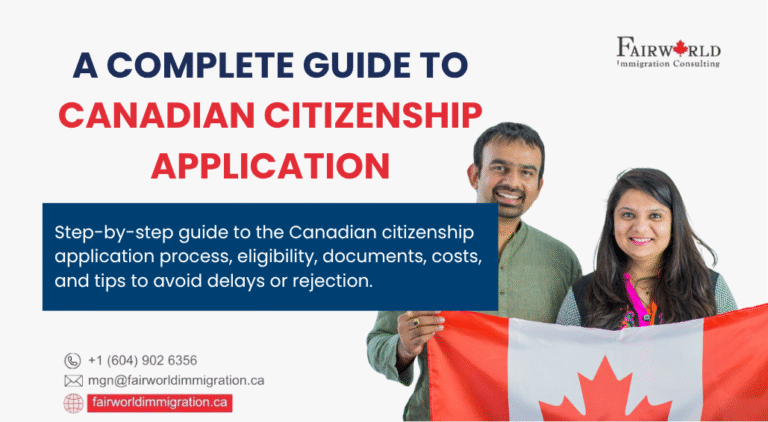How to Write an SOP for Canada after a Study Visa is Rejected
Updated on May 19th 2025 by Fairworld Immigration
Writing a Statement of Purpose (SOP) after experiencing a rejected study visa for Canada may be a hard and daunting project. Yet, it’s essential to do this with optimism, dedication, and a strategic mindset. Crafting a compelling SOP needs meticulous making of plans and astute expertise of what went incorrect initially. Let’s delve into key steps to create a sturdy SOP that improves your chances of securing a visa in your educational pursuit in Canada.
What is a SOP?
A Statement of Purpose (SOP) is a concise, personalized essay outlining a man or woman’s academic history, aspirations, and motives for applying to a specific academic application or group. It serves as a critical record in university packages, offering insights into an applicant’s desires, motives, and suitability for the selected path. The SOP offers a platform to articulate one’s passion, professional targets, and how the educational pursuit aligns with destiny aspirations. It’s a tool to exhibit particular traits, reports, and a compelling narrative that sets an applicant apart inside the aggressive landscape of admissions.
Significance of a Statement of Purpose (SOP) in Applications
The Statement of Purpose (SOP) is as a pivotal record in educational and professional packages, serving as an effective medium to showcase an applicant’s character and motive. Its significance resonates across numerous domain names, emphasizing several critical aspects:
Holistic Representation Beyond Grades
An SOP transcends beyond instructional transcripts and check scores, offering a complete narrative of an applicant’s journey. It gives a platform to articulate personal studies, motivations, and aspirations that shape one’s instructional or expert picks. This customized account unveils the person in the back of the qualifications, painting a brilliant picture for selection committees.
Showcasing Unique Attributes and Aspirations
It’s a canvas wherein candidates exhibit their forte. The SOP lets people spotlight their awesome traits, abilities, and achievements that set them apart from other applicants. By sharing personal anecdotes or experiences, applicants can show their ardor for a topic or professional path, enabling evaluators to gauge their dedication and enthusiasm.
Aligning Goals with Institution or Program
Crafting an SOP includes outlining motives for choosing a particular organization or application. This exercise encourages candidates to delve into researching the group’s values, assets, and offerings.
Decision-Influencing Factor
A well-crafted SOP often becomes a decisive aspect of the choice process. It offers insights into an applicant’s clarity of reason, communication competencies, and the way their aspirations align with the ethos of the organization or program. Admissions panels use the SOP as a lens to discover candidates who resonate with their values and dreams.
Understanding the Rejection:
The first step toward writing an impactful SOP post rejection is comprehending the grounds on which your previous application was denied. Analyze the rejection letter meticulously; it generally outlines the reasons behind the decision. Whether it is because of insufficient documentation, unclear professional dreams, or different elements, expertise in those points is vital.
Self-Reflection:
After going through the reasons, take a deep dive into your aspirations, academic plan, and goals. Reflect on your passion for the selected direction, how it aligns with your career plans, and why Canada especially holds importance in your educational pursuit.
Addressing Weaknesses:
Honesty is fundamental. Acknowledge the susceptible factors of your preceding application to your SOP. Whether it is because of a lack of clarity in dreams, insufficient documentation, or another trouble, cope with that head-on. But don’t reside on the negative. Focus greater on what you’ve found out and how you’ve stepped forward since the rejection.
Course and University Research:
Showcase a profound understanding of the course and college you’re applying to. Highlight why this particular application resonates with your educational aspirations. Explain the way it complements your previous training and bridges the space to your expertise or skills.
Career Aspirations:
Elaborate on your long-term career targets and the way the route in Canada is pivotal in reaching them. Present a clear and practical picture of ways this academic possibility aligns together with your professional trajectory.
Contribution to the Community:
Demonstrate your willingness to make a contribution to the Canadian economic network and society at large. Discuss how your talents, stories, and cultural heritage ought to increase the college environment and potential gain Canada in the future.
Financial Preparedness:
Provide robust proof of your financial preparedness to pursue schooling in Canada. Ensure all economic documents are in order, transparent, and meet the necessities set by the Canadian government.
Seek Expert Assistance:
Consider securing assistance from immigration experts or experts experienced in managing visa packages. Their insights can prove invaluable in expertise the nuances of crafting a successful SOP.
Writing the SOP:
Ensure your SOP is succinct, targeted, and well-written. Articulate your thoughts coherently, keeping an expert and formal tone. Avoid repetition and attention to quality over quantity.
Review and Edit:
Once you’ve drafted your SOP, revise it meticulously. Check for grammatical errors, coherence, and universal flow. Consider in search of comments from mentors, professors, or friends to benefit from unique perspectives.
Conclusion:
In the end, writing an SOP after rejection requires a delicate balance of acknowledging shortcomings while showcasing growth and resolution. It’s an opportunity to provide a more potent case for your candidacy. Remember, perseverance coupled with a properly crafted SOP can notably boost your possibilities of a successful visa application.
Final Thoughts:
Your journey doesn’t end with rejection; it’s an opportunity to improve your application with a more informed attitude. With meticulous plans, introspection, and a well-articulated SOP, you may pave the path for a successful visa utility to pursue your educational dreams in Canada.






